UTS Nursing: Prioritizing Complex Patient Health Issues Report
VerifiedAdded on 2022/09/18
|10
|2556
|23
Report
AI Summary
This report addresses the prioritization of complex patient health issues within the context of integrated nursing practice, specifically focusing on a case study involving a patient with COPD. The assignment identifies and prioritizes five key patient health issues, including compromised airway clearance, impaired gas exchange, and impaired oxygenation, emphasizing the importance of immediate attention in an emergency setting. The report provides a detailed rationale for the ranking, supported by current literature and the A-G assessment framework, highlighting the critical role of nurses in addressing these issues. Furthermore, it explores the legal and policy frameworks governing nursing practice, underscoring the importance of adhering to these guidelines to ensure effective and patient-centered care, including the prevention of malpractice and the provision of supplementary oxygen through oxygen therapy. The report concludes by emphasizing the need for medical practitioners to work within legal and ethical boundaries, which improves the quality of services offered.

Running head: PRIORITIZING OF COMPLEX PATENT HEALTH ISSUES 1
Prioritization of Complex Patient Health Issues
Student’s Name
Institutional Affiliation
Prioritization of Complex Patient Health Issues
Student’s Name
Institutional Affiliation
Paraphrase This Document
Need a fresh take? Get an instant paraphrase of this document with our AI Paraphraser
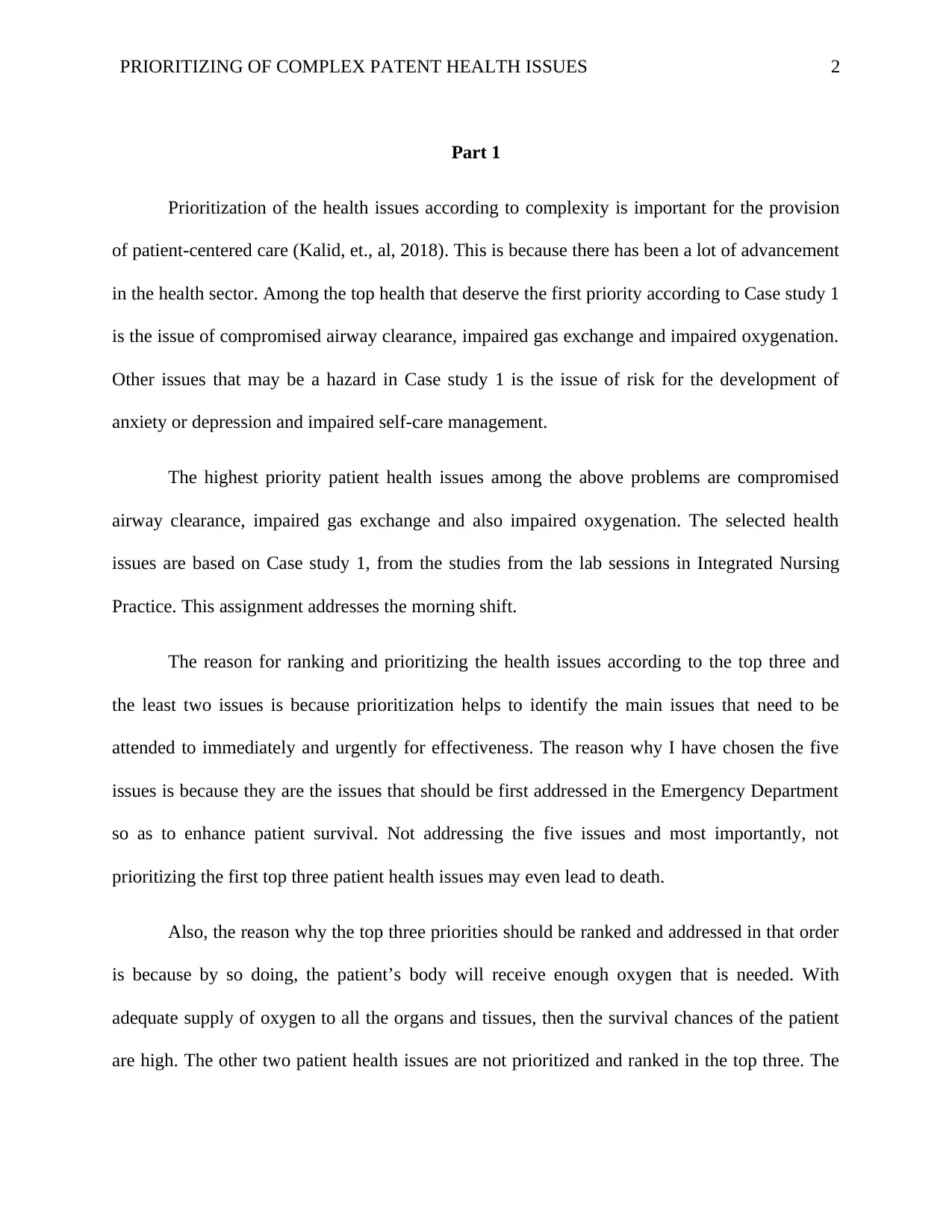
PRIORITIZING OF COMPLEX PATENT HEALTH ISSUES 2
Part 1
Prioritization of the health issues according to complexity is important for the provision
of patient-centered care (Kalid, et., al, 2018). This is because there has been a lot of advancement
in the health sector. Among the top health that deserve the first priority according to Case study 1
is the issue of compromised airway clearance, impaired gas exchange and impaired oxygenation.
Other issues that may be a hazard in Case study 1 is the issue of risk for the development of
anxiety or depression and impaired self-care management.
The highest priority patient health issues among the above problems are compromised
airway clearance, impaired gas exchange and also impaired oxygenation. The selected health
issues are based on Case study 1, from the studies from the lab sessions in Integrated Nursing
Practice. This assignment addresses the morning shift.
The reason for ranking and prioritizing the health issues according to the top three and
the least two issues is because prioritization helps to identify the main issues that need to be
attended to immediately and urgently for effectiveness. The reason why I have chosen the five
issues is because they are the issues that should be first addressed in the Emergency Department
so as to enhance patient survival. Not addressing the five issues and most importantly, not
prioritizing the first top three patient health issues may even lead to death.
Also, the reason why the top three priorities should be ranked and addressed in that order
is because by so doing, the patient’s body will receive enough oxygen that is needed. With
adequate supply of oxygen to all the organs and tissues, then the survival chances of the patient
are high. The other two patient health issues are not prioritized and ranked in the top three. The
Part 1
Prioritization of the health issues according to complexity is important for the provision
of patient-centered care (Kalid, et., al, 2018). This is because there has been a lot of advancement
in the health sector. Among the top health that deserve the first priority according to Case study 1
is the issue of compromised airway clearance, impaired gas exchange and impaired oxygenation.
Other issues that may be a hazard in Case study 1 is the issue of risk for the development of
anxiety or depression and impaired self-care management.
The highest priority patient health issues among the above problems are compromised
airway clearance, impaired gas exchange and also impaired oxygenation. The selected health
issues are based on Case study 1, from the studies from the lab sessions in Integrated Nursing
Practice. This assignment addresses the morning shift.
The reason for ranking and prioritizing the health issues according to the top three and
the least two issues is because prioritization helps to identify the main issues that need to be
attended to immediately and urgently for effectiveness. The reason why I have chosen the five
issues is because they are the issues that should be first addressed in the Emergency Department
so as to enhance patient survival. Not addressing the five issues and most importantly, not
prioritizing the first top three patient health issues may even lead to death.
Also, the reason why the top three priorities should be ranked and addressed in that order
is because by so doing, the patient’s body will receive enough oxygen that is needed. With
adequate supply of oxygen to all the organs and tissues, then the survival chances of the patient
are high. The other two patient health issues are not prioritized and ranked in the top three. The

PRIORITIZING OF COMPLEX PATENT HEALTH ISSUES 3
reason for not ranking the two is because they are just risks of causing patient health problem.
These two problems can be addressed later on but not during an emergency.
The two non-prioritized issues are mainly caused my lifestyle and other related social
issues. This issues are normally solved gradually with time, therefore, they cannot be prioritized
in the top three main emergency problems. The identification of the five issues and prioritizing
the top three main problems was based on the A-G Assessment in hospitals. It states that the
issues should be addressed starting with Airway first, then Breathing as second and finally
Circulation as the last issue. This pattern follows an alphabetical order, that is A, B and C.
Part 2
For effectiveness in the search and provision of the solutions to the above top three
patient health issues, it is important to rank the above top three issues that require immediate
attention from the first to the second and the last (Clarke, et., al, 2017). The importance of
ranking the top three patient health issues is because steps are normally taken when dealing with
these issues. Therefore, the ranking will help determine the most important and life-threatening
patient health issue to be dealt with first.
The steps should be done in the order of alphabet from A to E. This, in other words,
means that Airway should be the first one to be assessed (Pacey, 2018). This solves the patient
health issue of compromised airway clearance, which is the most life-threatening of the top three.
The next thing is to assess if the patient is breathing well. This solves the patient health issue of
impaired gas exchange. The next thing to be assessed should be Circulation. This solves the
reason for not ranking the two is because they are just risks of causing patient health problem.
These two problems can be addressed later on but not during an emergency.
The two non-prioritized issues are mainly caused my lifestyle and other related social
issues. This issues are normally solved gradually with time, therefore, they cannot be prioritized
in the top three main emergency problems. The identification of the five issues and prioritizing
the top three main problems was based on the A-G Assessment in hospitals. It states that the
issues should be addressed starting with Airway first, then Breathing as second and finally
Circulation as the last issue. This pattern follows an alphabetical order, that is A, B and C.
Part 2
For effectiveness in the search and provision of the solutions to the above top three
patient health issues, it is important to rank the above top three issues that require immediate
attention from the first to the second and the last (Clarke, et., al, 2017). The importance of
ranking the top three patient health issues is because steps are normally taken when dealing with
these issues. Therefore, the ranking will help determine the most important and life-threatening
patient health issue to be dealt with first.
The steps should be done in the order of alphabet from A to E. This, in other words,
means that Airway should be the first one to be assessed (Pacey, 2018). This solves the patient
health issue of compromised airway clearance, which is the most life-threatening of the top three.
The next thing is to assess if the patient is breathing well. This solves the patient health issue of
impaired gas exchange. The next thing to be assessed should be Circulation. This solves the
⊘ This is a preview!⊘
Do you want full access?
Subscribe today to unlock all pages.

Trusted by 1+ million students worldwide
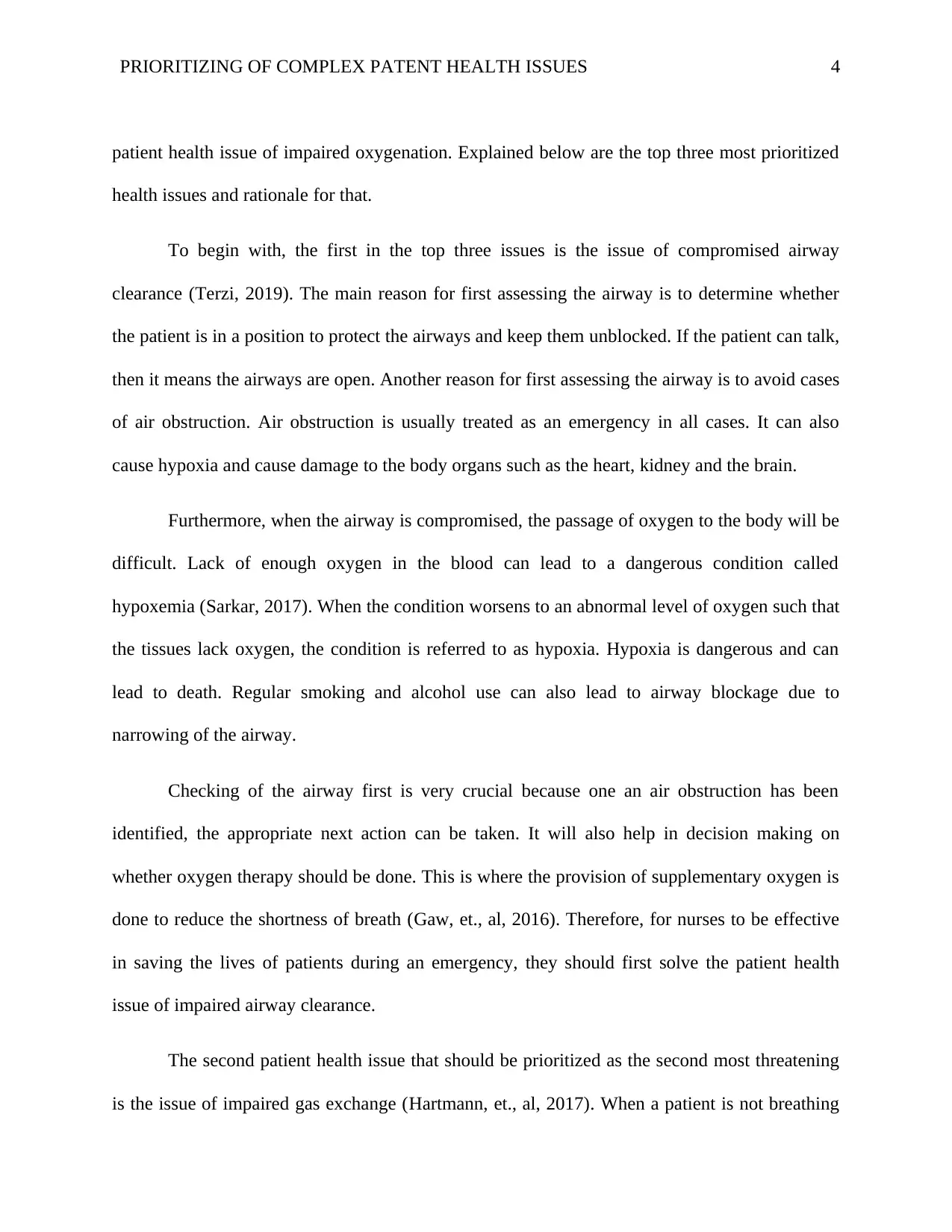
PRIORITIZING OF COMPLEX PATENT HEALTH ISSUES 4
patient health issue of impaired oxygenation. Explained below are the top three most prioritized
health issues and rationale for that.
To begin with, the first in the top three issues is the issue of compromised airway
clearance (Terzi, 2019). The main reason for first assessing the airway is to determine whether
the patient is in a position to protect the airways and keep them unblocked. If the patient can talk,
then it means the airways are open. Another reason for first assessing the airway is to avoid cases
of air obstruction. Air obstruction is usually treated as an emergency in all cases. It can also
cause hypoxia and cause damage to the body organs such as the heart, kidney and the brain.
Furthermore, when the airway is compromised, the passage of oxygen to the body will be
difficult. Lack of enough oxygen in the blood can lead to a dangerous condition called
hypoxemia (Sarkar, 2017). When the condition worsens to an abnormal level of oxygen such that
the tissues lack oxygen, the condition is referred to as hypoxia. Hypoxia is dangerous and can
lead to death. Regular smoking and alcohol use can also lead to airway blockage due to
narrowing of the airway.
Checking of the airway first is very crucial because one an air obstruction has been
identified, the appropriate next action can be taken. It will also help in decision making on
whether oxygen therapy should be done. This is where the provision of supplementary oxygen is
done to reduce the shortness of breath (Gaw, et., al, 2016). Therefore, for nurses to be effective
in saving the lives of patients during an emergency, they should first solve the patient health
issue of impaired airway clearance.
The second patient health issue that should be prioritized as the second most threatening
is the issue of impaired gas exchange (Hartmann, et., al, 2017). When a patient is not breathing
patient health issue of impaired oxygenation. Explained below are the top three most prioritized
health issues and rationale for that.
To begin with, the first in the top three issues is the issue of compromised airway
clearance (Terzi, 2019). The main reason for first assessing the airway is to determine whether
the patient is in a position to protect the airways and keep them unblocked. If the patient can talk,
then it means the airways are open. Another reason for first assessing the airway is to avoid cases
of air obstruction. Air obstruction is usually treated as an emergency in all cases. It can also
cause hypoxia and cause damage to the body organs such as the heart, kidney and the brain.
Furthermore, when the airway is compromised, the passage of oxygen to the body will be
difficult. Lack of enough oxygen in the blood can lead to a dangerous condition called
hypoxemia (Sarkar, 2017). When the condition worsens to an abnormal level of oxygen such that
the tissues lack oxygen, the condition is referred to as hypoxia. Hypoxia is dangerous and can
lead to death. Regular smoking and alcohol use can also lead to airway blockage due to
narrowing of the airway.
Checking of the airway first is very crucial because one an air obstruction has been
identified, the appropriate next action can be taken. It will also help in decision making on
whether oxygen therapy should be done. This is where the provision of supplementary oxygen is
done to reduce the shortness of breath (Gaw, et., al, 2016). Therefore, for nurses to be effective
in saving the lives of patients during an emergency, they should first solve the patient health
issue of impaired airway clearance.
The second patient health issue that should be prioritized as the second most threatening
is the issue of impaired gas exchange (Hartmann, et., al, 2017). When a patient is not breathing
Paraphrase This Document
Need a fresh take? Get an instant paraphrase of this document with our AI Paraphraser

PRIORITIZING OF COMPLEX PATENT HEALTH ISSUES 5
properly, then the exchange of gases in the body will not be effective. The reason for prioritizing
impaired gas exchange at number two is because the body needs to exchange gases by breathing
in oxygen and giving out carbon dioxide. This process is only facilitated by breathing, and
therefore without proper breathing, the impaired gas exchange will be experienced.
Another reason why impaired gas exchange should be addressed as number two is that
excess buildup of carbon dioxide is very harmful to the body. Retention of too much carbon
dioxide in the body to a vital condition referred to as hypercapnia (Nin, et., al, 2017). This
condition occurs when the alveoli collapse, hence leading to poor transportation of the
respiratory gases in the body.
Importantly, the impaired gas exchange should be prioritized since it can lead to
respiratory stress. Without proper breathing, the respiratory organs such as the lungs will not be
able to receive sufficient oxygen from the outside environment. This also means that carbon
dioxide and other toxic gases will not be excreted from the body. This insufficiency of oxygen
and buildup of toxic gases is what leads to respiratory stress.
When enough oxygen is not received in the brain, its functioning deteriorates. This is one
of the main reasons why dizziness is experienced by patients who are experiencing oxygen
deficiency. For this reason, the impaired gas exchange should be prioritized as number two for a
patient with injury or emergency cases.
Finally, impaired oxygenation is one of the other patient health issues that should be
addressed as number three. The main cause of impaired oxygenation is due to the inappropriate
circulation of oxygen in the body (McClatchey, et., al, 20170 The reason for addressing impaired
properly, then the exchange of gases in the body will not be effective. The reason for prioritizing
impaired gas exchange at number two is because the body needs to exchange gases by breathing
in oxygen and giving out carbon dioxide. This process is only facilitated by breathing, and
therefore without proper breathing, the impaired gas exchange will be experienced.
Another reason why impaired gas exchange should be addressed as number two is that
excess buildup of carbon dioxide is very harmful to the body. Retention of too much carbon
dioxide in the body to a vital condition referred to as hypercapnia (Nin, et., al, 2017). This
condition occurs when the alveoli collapse, hence leading to poor transportation of the
respiratory gases in the body.
Importantly, the impaired gas exchange should be prioritized since it can lead to
respiratory stress. Without proper breathing, the respiratory organs such as the lungs will not be
able to receive sufficient oxygen from the outside environment. This also means that carbon
dioxide and other toxic gases will not be excreted from the body. This insufficiency of oxygen
and buildup of toxic gases is what leads to respiratory stress.
When enough oxygen is not received in the brain, its functioning deteriorates. This is one
of the main reasons why dizziness is experienced by patients who are experiencing oxygen
deficiency. For this reason, the impaired gas exchange should be prioritized as number two for a
patient with injury or emergency cases.
Finally, impaired oxygenation is one of the other patient health issues that should be
addressed as number three. The main cause of impaired oxygenation is due to the inappropriate
circulation of oxygen in the body (McClatchey, et., al, 20170 The reason for addressing impaired
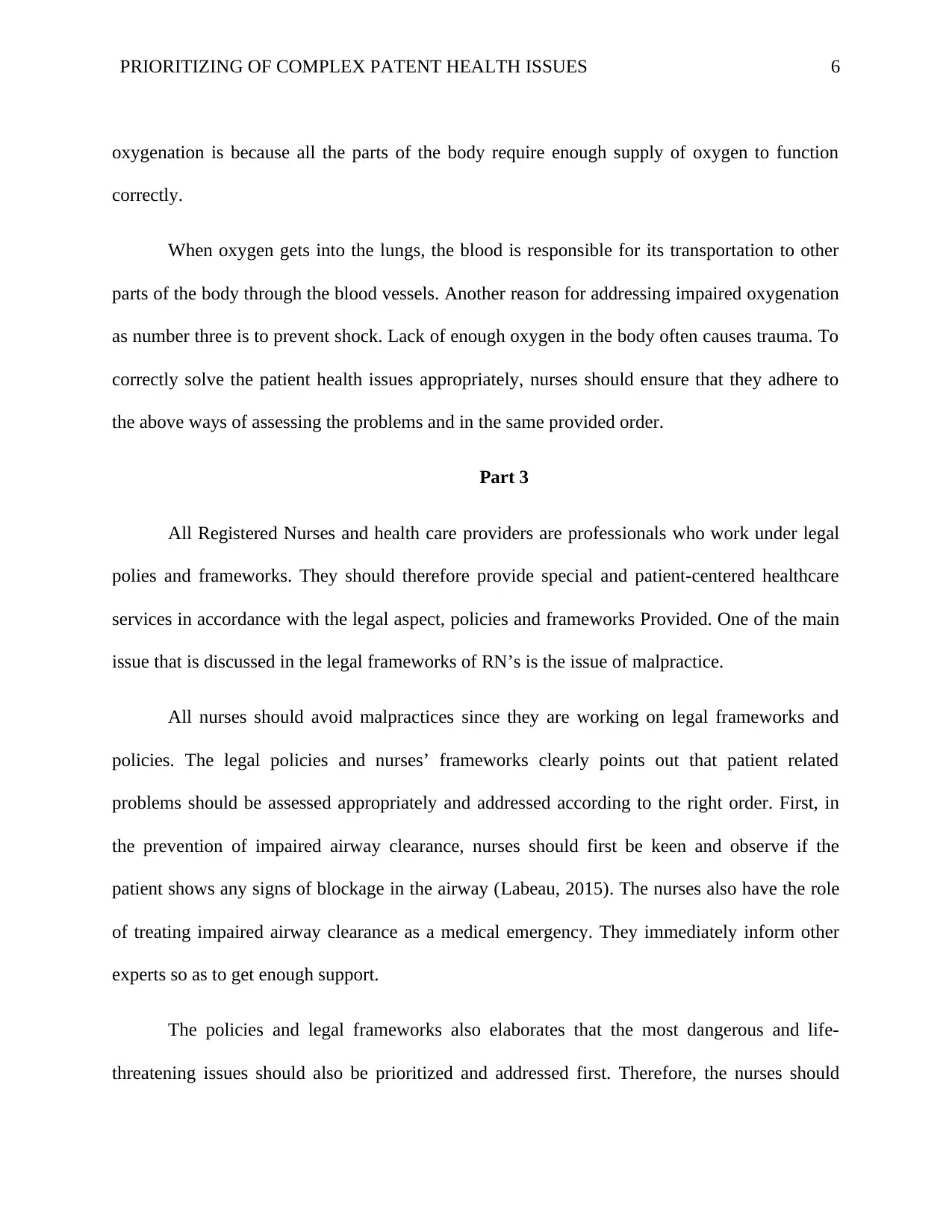
PRIORITIZING OF COMPLEX PATENT HEALTH ISSUES 6
oxygenation is because all the parts of the body require enough supply of oxygen to function
correctly.
When oxygen gets into the lungs, the blood is responsible for its transportation to other
parts of the body through the blood vessels. Another reason for addressing impaired oxygenation
as number three is to prevent shock. Lack of enough oxygen in the body often causes trauma. To
correctly solve the patient health issues appropriately, nurses should ensure that they adhere to
the above ways of assessing the problems and in the same provided order.
Part 3
All Registered Nurses and health care providers are professionals who work under legal
polies and frameworks. They should therefore provide special and patient-centered healthcare
services in accordance with the legal aspect, policies and frameworks Provided. One of the main
issue that is discussed in the legal frameworks of RN’s is the issue of malpractice.
All nurses should avoid malpractices since they are working on legal frameworks and
policies. The legal policies and nurses’ frameworks clearly points out that patient related
problems should be assessed appropriately and addressed according to the right order. First, in
the prevention of impaired airway clearance, nurses should first be keen and observe if the
patient shows any signs of blockage in the airway (Labeau, 2015). The nurses also have the role
of treating impaired airway clearance as a medical emergency. They immediately inform other
experts so as to get enough support.
The policies and legal frameworks also elaborates that the most dangerous and life-
threatening issues should also be prioritized and addressed first. Therefore, the nurses should
oxygenation is because all the parts of the body require enough supply of oxygen to function
correctly.
When oxygen gets into the lungs, the blood is responsible for its transportation to other
parts of the body through the blood vessels. Another reason for addressing impaired oxygenation
as number three is to prevent shock. Lack of enough oxygen in the body often causes trauma. To
correctly solve the patient health issues appropriately, nurses should ensure that they adhere to
the above ways of assessing the problems and in the same provided order.
Part 3
All Registered Nurses and health care providers are professionals who work under legal
polies and frameworks. They should therefore provide special and patient-centered healthcare
services in accordance with the legal aspect, policies and frameworks Provided. One of the main
issue that is discussed in the legal frameworks of RN’s is the issue of malpractice.
All nurses should avoid malpractices since they are working on legal frameworks and
policies. The legal policies and nurses’ frameworks clearly points out that patient related
problems should be assessed appropriately and addressed according to the right order. First, in
the prevention of impaired airway clearance, nurses should first be keen and observe if the
patient shows any signs of blockage in the airway (Labeau, 2015). The nurses also have the role
of treating impaired airway clearance as a medical emergency. They immediately inform other
experts so as to get enough support.
The policies and legal frameworks also elaborates that the most dangerous and life-
threatening issues should also be prioritized and addressed first. Therefore, the nurses should
⊘ This is a preview!⊘
Do you want full access?
Subscribe today to unlock all pages.

Trusted by 1+ million students worldwide

PRIORITIZING OF COMPLEX PATENT HEALTH ISSUES 7
assess the breathing pattern and the depth of each breath to determine whether the patient is
breathing properly. This can be done by listening, feeling or looking (Morandi, et., al, 2017).
Ensuring that the patient is breathing properly will facilitate the exchange of gases inside and
outside the body. They should also the movement of the chest and the diaphragm. If the
condition worsens, the nurses have the duty to provide supplementary oxygen through oxygen
therapy.
Registered Nurses according to the law are professionals who strictly follow and adhere
to the stipulated nursing laws and other health related policies. Finally, when it comes to the
patient health issue of impaired oxygenation, the nurses should ensure that there is sufficient
circulation of oxygen in the body (Barton, 2016) They should assess oxygen impairment by
observing the colour of the skin. Pulse rate also tells whether blood is pumped appropriately in
the heart. Nurses should, therefore, ensure that they address the issue of breathing and proper
functioning of the respiratory system to increase their outcome and efficiency during an
emergency or injury.
All medical practitioners should therefore be cautious when providing quality healthcare
services to patients. They should always avoid any breach, misconduct, misbehavior or
negligence. This rules and policies have been fruitful to the health sector since it has improved
the quality of services offered by medical practitioners. Therefore, all nurses and medical
practitioners should work according to this policies and legal frameworks for provision of better
services.
assess the breathing pattern and the depth of each breath to determine whether the patient is
breathing properly. This can be done by listening, feeling or looking (Morandi, et., al, 2017).
Ensuring that the patient is breathing properly will facilitate the exchange of gases inside and
outside the body. They should also the movement of the chest and the diaphragm. If the
condition worsens, the nurses have the duty to provide supplementary oxygen through oxygen
therapy.
Registered Nurses according to the law are professionals who strictly follow and adhere
to the stipulated nursing laws and other health related policies. Finally, when it comes to the
patient health issue of impaired oxygenation, the nurses should ensure that there is sufficient
circulation of oxygen in the body (Barton, 2016) They should assess oxygen impairment by
observing the colour of the skin. Pulse rate also tells whether blood is pumped appropriately in
the heart. Nurses should, therefore, ensure that they address the issue of breathing and proper
functioning of the respiratory system to increase their outcome and efficiency during an
emergency or injury.
All medical practitioners should therefore be cautious when providing quality healthcare
services to patients. They should always avoid any breach, misconduct, misbehavior or
negligence. This rules and policies have been fruitful to the health sector since it has improved
the quality of services offered by medical practitioners. Therefore, all nurses and medical
practitioners should work according to this policies and legal frameworks for provision of better
services.
Paraphrase This Document
Need a fresh take? Get an instant paraphrase of this document with our AI Paraphraser
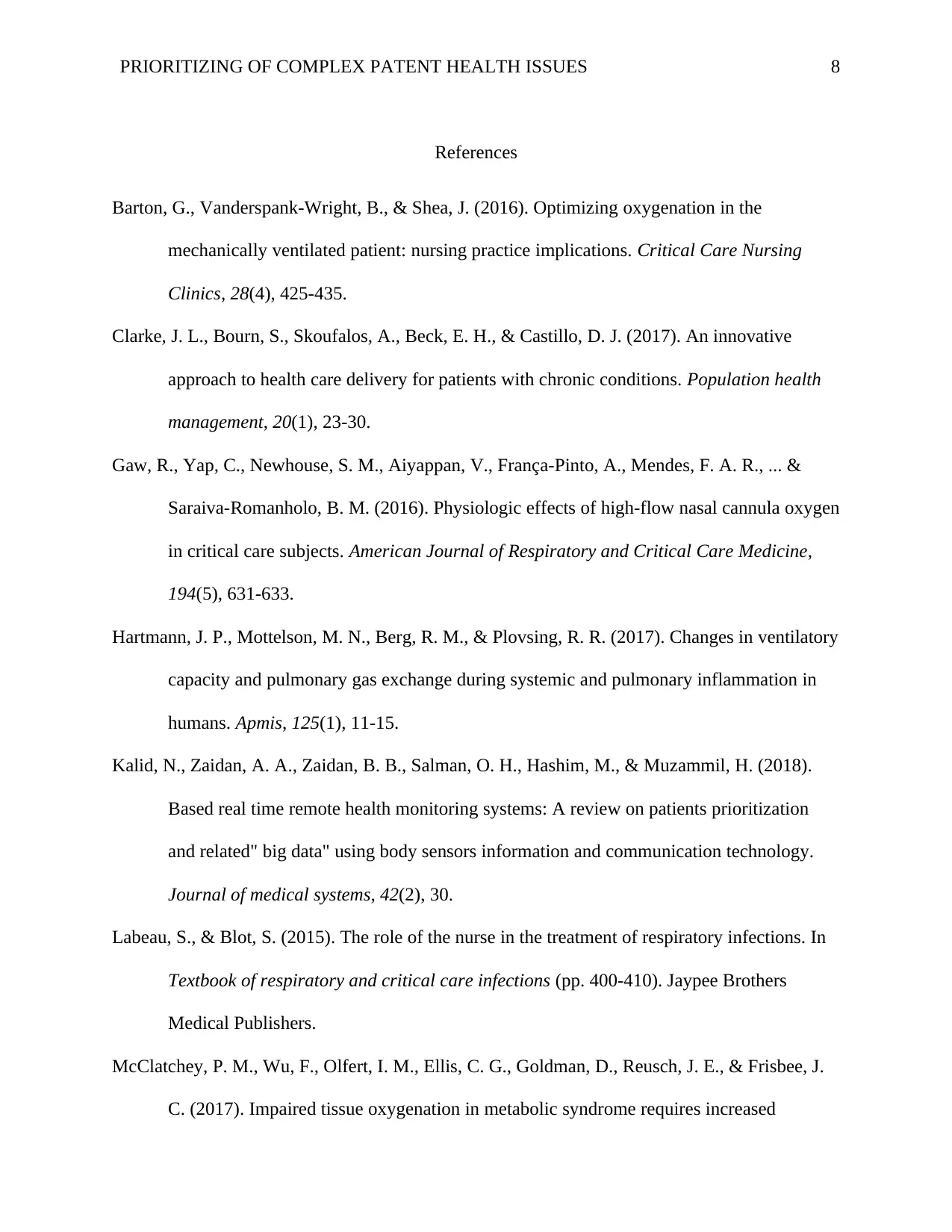
PRIORITIZING OF COMPLEX PATENT HEALTH ISSUES 8
References
Barton, G., Vanderspank-Wright, B., & Shea, J. (2016). Optimizing oxygenation in the
mechanically ventilated patient: nursing practice implications. Critical Care Nursing
Clinics, 28(4), 425-435.
Clarke, J. L., Bourn, S., Skoufalos, A., Beck, E. H., & Castillo, D. J. (2017). An innovative
approach to health care delivery for patients with chronic conditions. Population health
management, 20(1), 23-30.
Gaw, R., Yap, C., Newhouse, S. M., Aiyappan, V., França-Pinto, A., Mendes, F. A. R., ... &
Saraiva-Romanholo, B. M. (2016). Physiologic effects of high-flow nasal cannula oxygen
in critical care subjects. American Journal of Respiratory and Critical Care Medicine,
194(5), 631-633.
Hartmann, J. P., Mottelson, M. N., Berg, R. M., & Plovsing, R. R. (2017). Changes in ventilatory
capacity and pulmonary gas exchange during systemic and pulmonary inflammation in
humans. Apmis, 125(1), 11-15.
Kalid, N., Zaidan, A. A., Zaidan, B. B., Salman, O. H., Hashim, M., & Muzammil, H. (2018).
Based real time remote health monitoring systems: A review on patients prioritization
and related" big data" using body sensors information and communication technology.
Journal of medical systems, 42(2), 30.
Labeau, S., & Blot, S. (2015). The role of the nurse in the treatment of respiratory infections. In
Textbook of respiratory and critical care infections (pp. 400-410). Jaypee Brothers
Medical Publishers.
McClatchey, P. M., Wu, F., Olfert, I. M., Ellis, C. G., Goldman, D., Reusch, J. E., & Frisbee, J.
C. (2017). Impaired tissue oxygenation in metabolic syndrome requires increased
References
Barton, G., Vanderspank-Wright, B., & Shea, J. (2016). Optimizing oxygenation in the
mechanically ventilated patient: nursing practice implications. Critical Care Nursing
Clinics, 28(4), 425-435.
Clarke, J. L., Bourn, S., Skoufalos, A., Beck, E. H., & Castillo, D. J. (2017). An innovative
approach to health care delivery for patients with chronic conditions. Population health
management, 20(1), 23-30.
Gaw, R., Yap, C., Newhouse, S. M., Aiyappan, V., França-Pinto, A., Mendes, F. A. R., ... &
Saraiva-Romanholo, B. M. (2016). Physiologic effects of high-flow nasal cannula oxygen
in critical care subjects. American Journal of Respiratory and Critical Care Medicine,
194(5), 631-633.
Hartmann, J. P., Mottelson, M. N., Berg, R. M., & Plovsing, R. R. (2017). Changes in ventilatory
capacity and pulmonary gas exchange during systemic and pulmonary inflammation in
humans. Apmis, 125(1), 11-15.
Kalid, N., Zaidan, A. A., Zaidan, B. B., Salman, O. H., Hashim, M., & Muzammil, H. (2018).
Based real time remote health monitoring systems: A review on patients prioritization
and related" big data" using body sensors information and communication technology.
Journal of medical systems, 42(2), 30.
Labeau, S., & Blot, S. (2015). The role of the nurse in the treatment of respiratory infections. In
Textbook of respiratory and critical care infections (pp. 400-410). Jaypee Brothers
Medical Publishers.
McClatchey, P. M., Wu, F., Olfert, I. M., Ellis, C. G., Goldman, D., Reusch, J. E., & Frisbee, J.
C. (2017). Impaired tissue oxygenation in metabolic syndrome requires increased
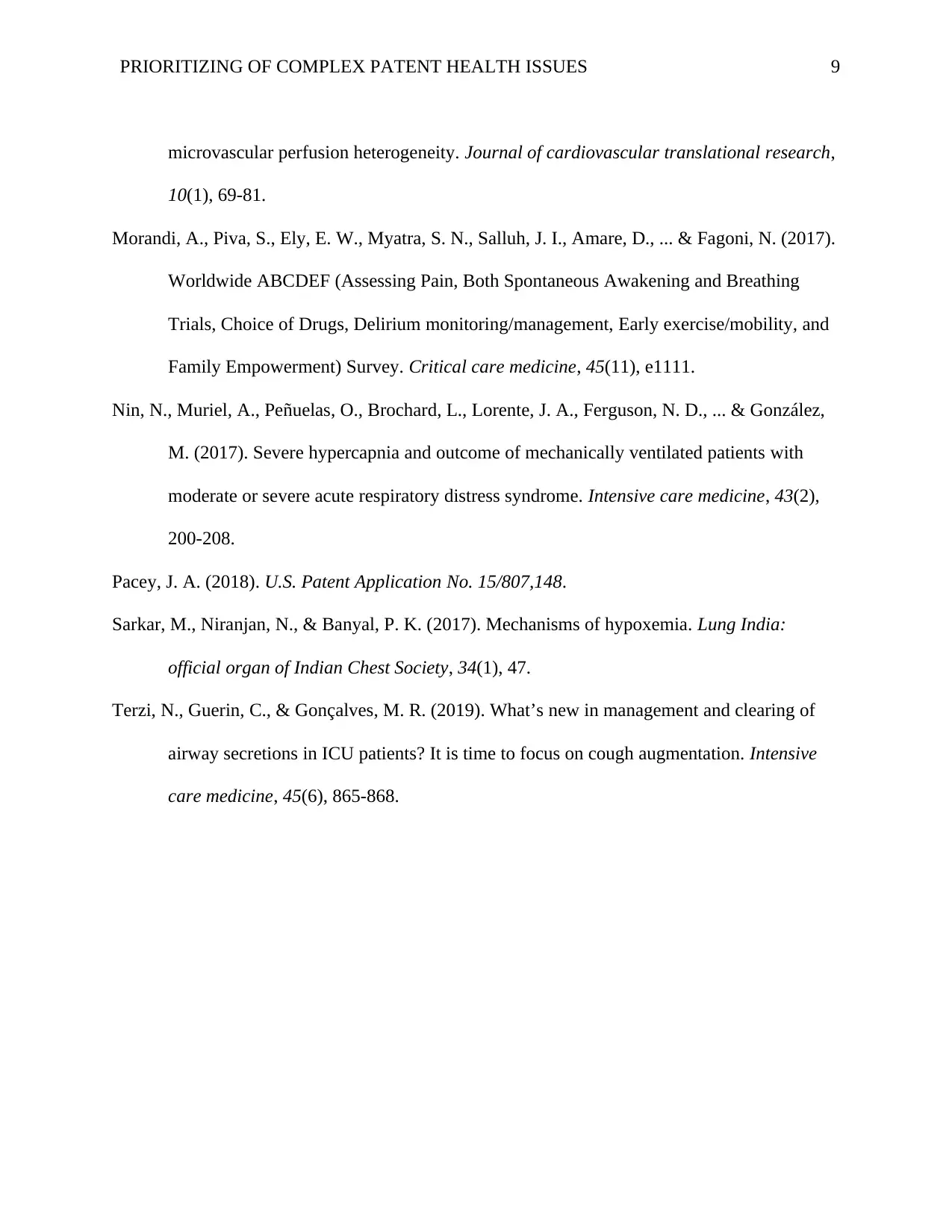
PRIORITIZING OF COMPLEX PATENT HEALTH ISSUES 9
microvascular perfusion heterogeneity. Journal of cardiovascular translational research,
10(1), 69-81.
Morandi, A., Piva, S., Ely, E. W., Myatra, S. N., Salluh, J. I., Amare, D., ... & Fagoni, N. (2017).
Worldwide ABCDEF (Assessing Pain, Both Spontaneous Awakening and Breathing
Trials, Choice of Drugs, Delirium monitoring/management, Early exercise/mobility, and
Family Empowerment) Survey. Critical care medicine, 45(11), e1111.
Nin, N., Muriel, A., Peñuelas, O., Brochard, L., Lorente, J. A., Ferguson, N. D., ... & González,
M. (2017). Severe hypercapnia and outcome of mechanically ventilated patients with
moderate or severe acute respiratory distress syndrome. Intensive care medicine, 43(2),
200-208.
Pacey, J. A. (2018). U.S. Patent Application No. 15/807,148.
Sarkar, M., Niranjan, N., & Banyal, P. K. (2017). Mechanisms of hypoxemia. Lung India:
official organ of Indian Chest Society, 34(1), 47.
Terzi, N., Guerin, C., & Gonçalves, M. R. (2019). What’s new in management and clearing of
airway secretions in ICU patients? It is time to focus on cough augmentation. Intensive
care medicine, 45(6), 865-868.
microvascular perfusion heterogeneity. Journal of cardiovascular translational research,
10(1), 69-81.
Morandi, A., Piva, S., Ely, E. W., Myatra, S. N., Salluh, J. I., Amare, D., ... & Fagoni, N. (2017).
Worldwide ABCDEF (Assessing Pain, Both Spontaneous Awakening and Breathing
Trials, Choice of Drugs, Delirium monitoring/management, Early exercise/mobility, and
Family Empowerment) Survey. Critical care medicine, 45(11), e1111.
Nin, N., Muriel, A., Peñuelas, O., Brochard, L., Lorente, J. A., Ferguson, N. D., ... & González,
M. (2017). Severe hypercapnia and outcome of mechanically ventilated patients with
moderate or severe acute respiratory distress syndrome. Intensive care medicine, 43(2),
200-208.
Pacey, J. A. (2018). U.S. Patent Application No. 15/807,148.
Sarkar, M., Niranjan, N., & Banyal, P. K. (2017). Mechanisms of hypoxemia. Lung India:
official organ of Indian Chest Society, 34(1), 47.
Terzi, N., Guerin, C., & Gonçalves, M. R. (2019). What’s new in management and clearing of
airway secretions in ICU patients? It is time to focus on cough augmentation. Intensive
care medicine, 45(6), 865-868.
⊘ This is a preview!⊘
Do you want full access?
Subscribe today to unlock all pages.

Trusted by 1+ million students worldwide

PRIORITIZING OF COMPLEX PATENT HEALTH ISSUES
10
10
1 out of 10
Related Documents
Your All-in-One AI-Powered Toolkit for Academic Success.
+13062052269
info@desklib.com
Available 24*7 on WhatsApp / Email
![[object Object]](/_next/static/media/star-bottom.7253800d.svg)
Unlock your academic potential
Copyright © 2020–2025 A2Z Services. All Rights Reserved. Developed and managed by ZUCOL.




